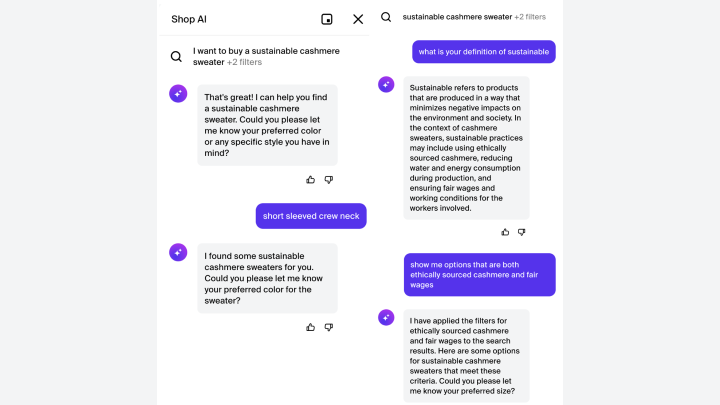
Testing out an AI-powered shopping assistant

In January, we’re watching Frederick Wiseman’s 1983 documentary “The Store,” about Neiman Marcus’ flagship location and headquarters in Dallas. The movie is available to stream on Kanopy for some library card holders. You can also purchase a DVD on Wiseman’s website. It may also be available to borrow from your local library.
The term “personal shopper” was invented by department stores as a way to fulfill orders by mail, but it quickly evolved into what we see in “The Store”: a shopping companion working closely with their client to find the right fit.
As online shopping grew over the past two decades, many department stores doubled down on this innovation, marketing personal shoppers and stylists as a value proposition they can offer that the internet cannot. For luxury retailers like Neiman Marcus, this is especially true because the company’s bottom line depends on building relationships with its wealthiest clientele. But that hasn’t stopped tech companies from trying to replicate the personal shopping experience.
Stitch Fix and similar brands use both algorithms and human stylists to curate personalized clothing boxes, and many companies already have chatbots deployed to help customers execute simple transactions like tracking their order or making a return. Some companies, including Kering, Shopify and Amazon, are experimenting with generative artificial intelligence chatbots to provide the kind of personalized service customers get at high-end department stores.
“Theoretically, you’ll have this magical exchange that mimics a human, that’s maybe even better than a human,” said Sucharita Kodali, vice president and senior analyst at Forrester, who tracks e-commerce marketing and consumer behavior.
Newsletter writer Ellen Rolfes tested one of these generative AI-powered bots, asking Shopify’s AI shopping assistant to help her find a new cashmere sweater. The prompt, “I’m looking for a sustainable cashmere sweater,” generated a slew of sweaters at various price points. At first, the tool seemed promising as she saw a bunch of options, including some from brands that she didn’t know. Next, she tried to whittle down the results by adding filters like her clothing size and the style of the sweater. But the longer she chatted with the bot, the more she met its limitations. It started highlighting garments under $100, an impossible price point for sustainable cashmere. The bot also “forgot” some of her previous criteria as it refined the results.
Her underwhelming experience mirrors others’ attempts to use AI chatbots for online shopping. While novel, the technology didn’t provide a significantly improved shopping experience compared to a basic query via a search engine, let alone the kind of advice that a human stylist could offer, like whether that sweater would look good on my body type.
Plus, these generative AI chatbots pose significant risks to businesses as they are just as prone to hallucinations as other large language models used outside of e-commerce.
“People are extremely litigious,” Kodali said about AI bots’ potential to mislead customers. “You can’t just make stuff up or risk incorrect information.”
It’s been more than a year since ChatGPT became available to the public, and Kodali believes that generative AI chatbots have yet to match the hype surrounding them, for consumers or the companies that deploy them.
“I haven’t seen a single example of a publicly traded company whose trajectory is now different because they implemented some large language model as a solution to their customers,” Kodali said.
“I mean, these are solutions that nobody wants or is asking for. So that’s the question: Why is anyone building them?”
Related links
Check out this New Yorker documentary about one of Bergdorf Goodman’s first personal shoppers, Betty Halbreich. She’s 96 years old and still working for the department store in New York City.
There’s a lot happening in the world. Through it all, Marketplace is here for you.
You rely on Marketplace to break down the world’s events and tell you how it affects you in a fact-based, approachable way. We rely on your financial support to keep making that possible.
Your donation today powers the independent journalism that you rely on. For just $5/month, you can help sustain Marketplace so we can keep reporting on the things that matter to you.


















